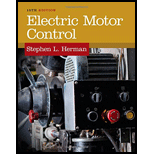
Electric Motor Control
10th Edition
ISBN: 9781133702818
Author: Herman
Publisher: CENGAGE L
expand_more
expand_more
format_list_bulleted
Question
Chapter 42, Problem 7SQ
To determine
Explain the reason for polarization of PFR with a DC coil.
Expert Solution & Answer
Want to see the full answer?
Check out a sample textbook solution
Students have asked these similar questions
Use Newton-Raphson method to solve the system
x³+y-1=0
4
y³-x+1=0
with the starting value (xo,yo) = (1,0). Take n=4.
Use Newton-Raphson method to solve the system
3x²y - 10x+7=0
y²-5y+4=0
With the starting value (xo, yo) = (0.5, 0.5). Take n = 1
Use Newton-Raphson method to solve the system
x²-2xy+0.5= 0
x²+4y² 40
-
with the starting value (xo, yo) = (2, 0.25) and two iteration number.
Chapter 42 Solutions
Electric Motor Control
Ch. 42 - What are the two basic methods of automatically...Ch. 42 - What is an out-of-step relay?Ch. 42 - Why is an out-of-step relay used on automatic...Ch. 42 - Under what conditions will the out-of-step relay...Ch. 42 - What is the last control contact that closes on a...Ch. 42 - What influence do both of the polarized field...Ch. 42 - Prob. 7SQCh. 42 - Approximately how much time (in terms of...Ch. 42 - How does the AC coil of the PFR receive the...Ch. 42 - Why is a control relay (CR1) used in Figure 426?...
Knowledge Booster
Learn more about
Need a deep-dive on the concept behind this application? Look no further. Learn more about this topic, electrical-engineering and related others by exploring similar questions and additional content below.Similar questions
- Problem 7 [2.5 pts] The response of an LTI system to u[n+2] appears to be the following sequence. -3-2-101234 Do we have enough information to determine the impulse response of this system? If so, derive it and plot it. If not, explain why.arrow_forwardProblem 4 5' Consider the systems S₁(x[n]) = x[n]+5[n²−1] and S2(x[n]) = x[n(n−2)]. a [2 pts] Plot the impulse responses of S₁ and S2, respectively. b [2.5 pts] Determine whether S₁ and S2 are causal. Justify your answer in details. Warning: There will be no credit for just 'yes' or 'no' answer.arrow_forward22: Line charges PL 2π nC/m are located at xy-plane as shown in Figure-1, find the electric field intensity (E) at (0, 0, 2)? 2arrow_forward
- 11.4 Determine Vout in the circuit shown in Fig. P11.4. through any methodarrow_forwardSolve the following nonlinear system using Newton's method 1 f1(x1, x2, x3)=3x₁ = cos(x2x3) - - 2 f2(x1, x2, x3) = x² - 81(x2 +0.1)² + sin x3 + 1.06 f3(x1, x2, x3) = ex1x2 +20x3 + Using x (0) X1 X2 X3 10π-3 3 = 0.1, 0.1, 0.1 as initial conditioarrow_forwardUse Newton-Raphson method to solve the system x² - 2x-y+0.5= 0 x² + 4y² 4 = 0 - with the starting value (xo,yo) = (2,0.25) and two iteration number.arrow_forward
- Reversing 3⍉ Motors using manual starters with wiring diagram of forward contacts and reverse contacts.arrow_forwardDetermine (a) the input impedance and (b) the reflectedimpedance, both at terminals (a,b) in the circuit of Fig. P11.14.arrow_forward11.4 Determine Vout in the circuit shown in Fig. P11.4.arrow_forward
- For the circuit in Fig. P11.1, determine (a) iL(t) and (b) theaverage power dissipated in RL.arrow_forwardDesign a synchronous Up/Down counter to produce the following sequence (4 9 2,0,7,6,3,1,5) using T flip-flop. The counter should count up when Up/Down =1, and down when Up/Down = 0.arrow_forwardSolve the following systems using Gauss Seidal and Jacobi iteration methods for n=8 and initial values X0=(000). - 2x16x2 x3 = -38 - -3x1 x2+7x3 = −34 -8x1 + x2 - 2x3 = -20arrow_forward
arrow_back_ios
SEE MORE QUESTIONS
arrow_forward_ios
Recommended textbooks for you

 Power System Analysis and Design (MindTap Course ...Electrical EngineeringISBN:9781305632134Author:J. Duncan Glover, Thomas Overbye, Mulukutla S. SarmaPublisher:Cengage Learning
Power System Analysis and Design (MindTap Course ...Electrical EngineeringISBN:9781305632134Author:J. Duncan Glover, Thomas Overbye, Mulukutla S. SarmaPublisher:Cengage Learning Electricity for Refrigeration, Heating, and Air C...Mechanical EngineeringISBN:9781337399128Author:Russell E. SmithPublisher:Cengage Learning
Electricity for Refrigeration, Heating, and Air C...Mechanical EngineeringISBN:9781337399128Author:Russell E. SmithPublisher:Cengage Learning


Power System Analysis and Design (MindTap Course ...
Electrical Engineering
ISBN:9781305632134
Author:J. Duncan Glover, Thomas Overbye, Mulukutla S. Sarma
Publisher:Cengage Learning

Electricity for Refrigeration, Heating, and Air C...
Mechanical Engineering
ISBN:9781337399128
Author:Russell E. Smith
Publisher:Cengage Learning
02 - Sinusoidal AC Voltage Sources in Circuits, Part 1; Author: Math and Science;https://www.youtube.com/watch?v=8zMiIHVMfaw;License: Standard Youtube License